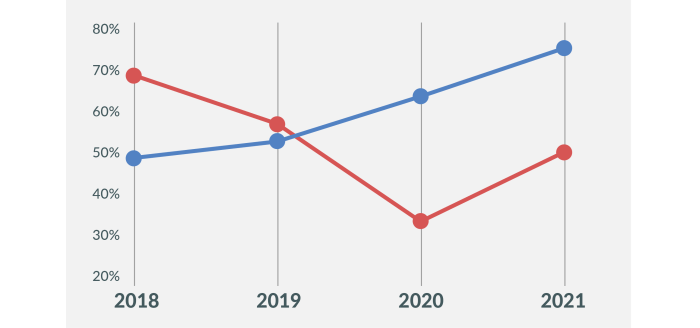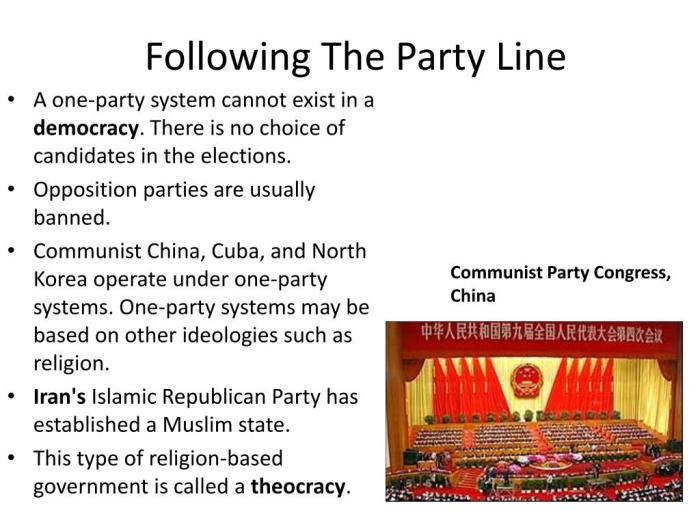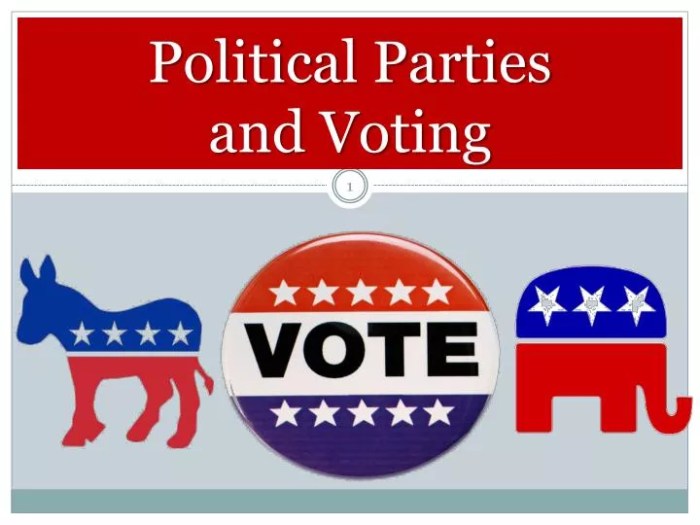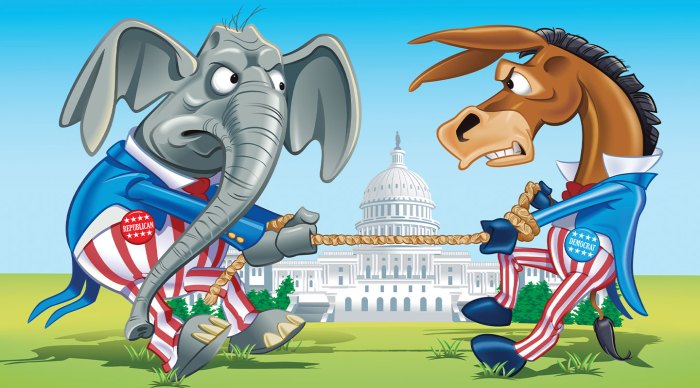Party line voting definition ap gov, a prevalent phenomenon in American politics, refers to the practice of legislators consistently voting in accordance with their party’s position, regardless of their personal beliefs or the merits of the issue at hand. This practice has significant implications for legislative effectiveness, representation, and public trust, and has evolved over time due to various factors.
The historical development of party line voting in the United States has been influenced by the rise of political parties, the decline of party loyalty, and the increasing polarization of the electorate. As a result, party line voting has become more common in recent decades, with legislators increasingly voting along party lines even on issues where there is significant public support for alternative positions.
Definition of Party Line Voting: Party Line Voting Definition Ap Gov
Party line voting refers to the practice in American politics where legislators vote in accordance with the position of their political party on a particular issue, rather than based on their personal beliefs or the interests of their constituents.
Reasons for Party Line Voting
There are several reasons why legislators may choose to vote along party lines:
- Party loyalty:Legislators may feel a sense of loyalty to their party and its platform, and may believe that it is important to support the party’s position on issues.
- Constituent expectations:Legislators may believe that their constituents expect them to vote in accordance with the party’s position on issues.
- Political expediency:Legislators may believe that voting along party lines is the most politically expedient course of action, as it can help them maintain support from their party and its base.
- Lack of information:Legislators may not have the time or resources to fully research and understand all of the issues that come before them, and may therefore rely on the party’s position as a guide for their own votes.
- Influence of party leadership:Party leaders may have a significant influence over the voting behavior of their members, and may use a variety of means to encourage party line voting, such as offering rewards or punishments.
Historical Evolution of Party Line Voting

Party line voting has evolved over time in the United States, influenced by several key factors. In the early years of the republic, party lines were fluid, and members of Congress often voted across party lines on issues of regional or personal interest.
However, the rise of national political parties in the mid-19th century led to a gradual increase in party line voting.
Key Factors Influencing the Increase in Party Line Voting, Party line voting definition ap gov
- Polarization of political parties:Over time, the two major political parties, the Democrats and Republicans, have become increasingly polarized on ideological grounds. This polarization has made it more difficult for members of Congress to find common ground and compromise across party lines.
- Increased party discipline:Party leaders have become more assertive in enforcing party discipline, rewarding members who vote with the party and punishing those who do not. This has made it more difficult for members of Congress to break with their party on key votes.
- Role of the media:The rise of partisan media outlets, such as Fox News and MSNBC, has contributed to the polarization of political parties and increased the pressure on members of Congress to vote along party lines.
Consequences of Party Line Voting

Party line voting, while ensuring party discipline and unity, can have both positive and negative consequences for legislative effectiveness, representation, and public trust.
Positive Consequences
*
-*Increased Legislative Effectiveness
Party line voting can facilitate the passage of legislation by ensuring that a majority of the party’s members support it. This can streamline the legislative process and reduce delays caused by debates and amendments.
-*Enhanced Party Discipline
Party line voting strengthens party cohesion and discipline. It ensures that party members present a unified front, which can increase their bargaining power and influence over legislation.
Negative Consequences
Legislative Effectiveness
*
-*Reduced Deliberation and Debate
Party line voting can stifle healthy debate and compromise on policymaking. Members may be less inclined to consider alternative viewpoints or compromise with the opposition if they are expected to toe the party line.
-*Gridlock and Partisanship
Extreme party line voting can lead to gridlock and partisan divisions, as both parties become more entrenched in their positions and less willing to negotiate.
Representation
*
-*Erosion of Constituent Representation
Party line voting may result in legislators prioritizing party interests over the needs of their constituents. This can lead to policies that do not reflect the diverse perspectives of the electorate.
-*Weakened Independent Voices
Party line voting can suppress independent voices and discourage legislators from expressing their own views if they differ from the party platform.
Public Trust
*
-*Loss of Public Confidence
Excessive party line voting can erode public trust in the political process. Citizens may perceive it as a sign of partisanship and a lack of responsiveness to their concerns.
-*Reduced Electoral Participation
Public dissatisfaction with party line voting can lead to lower voter turnout and decreased participation in the political process.
Factors Influencing Party Line Voting

Party line voting is influenced by several factors, including party leadership, constituent preferences, and electoral incentives.
Party leaders play a crucial role in shaping their party’s agenda and influencing their members’ voting behavior. They can use their authority to reward or punish members who deviate from the party line, and they can also use their influence to persuade members to support their positions.
Constituent Preferences
Constituent preferences also play a role in party line voting. Legislators are more likely to vote in line with their constituents’ preferences, especially if they are facing reelection. This is because constituents tend to reward legislators who represent their interests, and they can punish legislators who do not.
Electoral Incentives
Electoral incentives also influence party line voting. Legislators are more likely to vote in line with their party’s platform if they believe that doing so will help them get reelected. This is because voters tend to favor candidates who are seen as being loyal to their party.
Strategies to Reduce Party Line Voting

Party line voting has become increasingly prevalent in recent years, leading to concerns about the decline of bipartisanship and the ability of the government to effectively address the nation’s challenges. Various strategies have been proposed to reduce party line voting and promote more bipartisan cooperation.
Campaign Finance Regulation
One strategy is to reform campaign finance laws to reduce the influence of special interests and wealthy donors. Critics argue that the current system allows corporations and wealthy individuals to exert undue influence over politicians, leading them to prioritize the interests of their donors over the needs of the broader public.
By limiting campaign contributions and increasing transparency in campaign finance, it is hoped that politicians will be less beholden to special interests and more responsive to the concerns of their constituents.
Redistricting Reform
Another strategy is to reform redistricting processes to create more competitive districts. Currently, many districts are drawn in a way that makes it difficult for the minority party to win elections. This can lead to safe districts where incumbents are virtually guaranteed re-election, regardless of their party affiliation.
By creating more competitive districts, it is hoped that candidates will be more responsive to the needs of voters in order to win elections.
Electoral Reforms
Electoral reforms, such as ranked-choice voting or proportional representation, have also been proposed as a way to reduce party line voting. Ranked-choice voting allows voters to rank candidates in order of preference, rather than simply voting for one candidate. This can help to ensure that the winner of an election is the candidate who is most preferred by the majority of voters, even if they do not win a majority of first-choice votes.
Proportional representation systems allocate seats in the legislature based on the proportion of votes received by each party, rather than simply giving all seats to the party that wins the most votes in each district. This can help to ensure that minority parties have a voice in the legislature and that the legislature is more representative of the diversity of views within the electorate.
Other Strategies
Other strategies that have been proposed to reduce party line voting include:
- Increasing the use of bipartisan committees and task forces
- Encouraging more dialogue and cooperation between members of different parties
- Promoting a culture of civility and respect in political discourse
Expert Answers
What is party line voting?
Party line voting is the practice of legislators consistently voting in accordance with their party’s position, regardless of their personal beliefs or the merits of the issue at hand.
What are the reasons for party line voting?
There are a number of reasons for party line voting, including party loyalty, constituent preferences, and electoral incentives.
What are the consequences of party line voting?
Party line voting can have both positive and negative consequences, including promoting party unity and discipline, ensuring that the party’s platform is implemented, leading to gridlock and inaction, and preventing legislators from representing the views of their constituents.